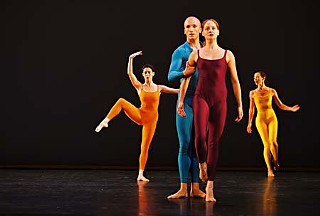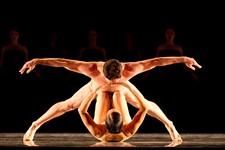Merce Cunningham Dance Company
The last chance, in every sense
By Andrew Long, Fri., March 4, 2011
Merce Cunningham was a soft-spoken man. He expressed himself so clearly as a dancer and choreographer, with a brilliant command of artistic time and space. His work is riveting.
I will never forget watching a series of rehearsals at Anna Hiss Gym in 1989 during his residency at the University of Texas. To signal the dancers to take their places, Cunningham lightly cupped his hands together in a clapping motion several times. Although the sound was barely audible, dancers quickly responded. What was astonishing was that Cunningham's signal was so effortless yet so powerful. His energy galvanized that room as it had done for decades onstage.
In 1964, the Merce Cunningham Dance Company (along with then-company dancer Deborah Hay) embarked on a six-month tour through Europe and Asia that put Cunningham on the international map. Since then, the company has been touring the world nonstop and is currently doing so one final time.
Before his death in 2009, Cunningham developed a precedent-setting plan to address what would become of his work after he passed. That plan includes the Legacy Tour, a two-year international company tour, which, sadly, will be the company's last. Lucky for us, Austin made the list of tour stops, along with Berlin, Hong Kong, Jerusalem, Mexico City, Moscow, and Paris. Afterward, the company will disband and Cunningham's legacy will be preserved through the Merce Cunningham Trust.
Cunningham, who choreographed more than 150 works and 800 events, ranks among the 20th century dance greats, alongside Isadora Duncan, Martha Graham, and George Balanchine. His impact and influence cannot be overstated, given all the dancers who danced for him and then went on to form their own companies, among them Paul Taylor, Trisha Brown, Lucinda Childs, and Karole Armitage.
One of Cunningham's strengths was surrounding himself with great talent – and not only dancers. He was instrumental in the use of avant-garde composers, from David Tudor, Christian Wolff, and Morton Feldman to Radiohead, Brian Eno, and Sonic Youth. He recruited major artists to design sets for him, including Andy Warhol, Frank Stella, Bruce Nauman, Robert Rauschenberg, and Jasper Johns.
For more than half a century, Cunningham made dance after dance without implicit meaning other then the exploration of time, space, and form. It was an artist's pure expression with viewers left to their own interpretations. Cunningham was a titan of this approach as well as one of the first dance makers to embrace film and computer technology as a choreographic compositional tool.
His inclusion of chance operation, pioneered by his lifelong partner John Cage, was pivotal in his work. There was no right way, no perfect dance. Rather he trusted the cosmic gifts that chance would bring. For some, Cunningham's work was too reserved and cool, while others heralded it for its detachment from outcome, embracing a Zen Buddhist approach.
Cunningham summed it up so beautifully: "My work has always been in process. Finishing a dance has left me with the idea, often slim in the beginning, for the next one. In that way, I do not think of each dance as an object, rather a short stop on the way."
This is the last chance. The Legacy Tour is one short stop you will want to experience.
The Merce Cunningham Dance Company Legacy Tour performs Tuesday, March 8, 8pm, at Bass Concert Hall, East 23rd & Robert Dedman Dr. For more information, call 477-6060 or visit www.texasperformingarts.org.









